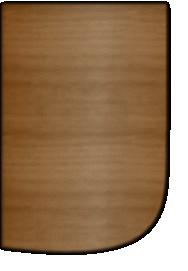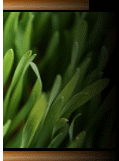



Rectangular growbeds
View the slideshow to see the evolution of the construction of my system.
For the rectangular growbeds I used the same construction method as for the floating rafts tanks.
The bottom and sides of these tanks are constructed out of a 5 mm multiplex board stapled to a frame made of 45 x 20 mm ribs.
The bottom measures 3 m x 1 m , the sides are 30 mm high.
On the inside, 90° bookshelf supports are screwed to both bottom and sides for strengthening.
A thick agricultural polyethylene foil is then spread over the tank and carefully folded into the corners. Takes a bit of adjustmentand patience, but the rectangular form of the tank is a big help.
Kid of wrapping a birthday present inside out. Not really difficult, just make sure the folds in the corners always take the foil up to the rim of the tank, else it will be leaking
The rims of the foil are folded over the sides and stapled to the frame.
I have the intention of filling the gaps between the frame ribs with insulation and staple a second 5 mm board against them to close up, then screw a plastic or aluminum L-profile all around the rim and on the corners for finishing touch.
A 50 mm tank drain fitting is installed in each growbed.
For that I use a guide made of a 20 mm piece of board with a hole drilled in it with the corresponding hole saw. I weigh that down to hold it in place.
With an exacto knife I then first cut the corresponding hole out of the foil, helped by the guide. This is important, lest the teeth of your hole saw wrap up the foil while drilling (been there, done that).
After that, cutting the hole through the bottom with the hole saw and mounting the fitting and pipes or gutters back to the sump is childs play.
I prefer using gutters for the added passive aeration - see the "pumping and aeration" page.
In my system I use the "fast fill, slow drain" (FFSD) method for flood and drain on these growbeds - see the "flood and drain" page - as this allows me to control the frequency of flood and drain to my liking.
A 50 mm overflow pipe is loosely slided into the drain fitting. One or several holes in the top part of the fitting and corresponding holes in the overflow pipe bottom part allow for aligning more or less these holes (thus "pinching" the outlet) to ensure that the growbed drains slower than it fills.
A quick turn left and right allows me to cut any small roots that threaten to block the holes.
On the bottom of the growbed, a layer of 50 mm of water retaining media is colonised by nitrifying bacteria to ensure biofiltration. This layer drains to avoid anaerobic circumstances, but will never dry out enough to threaten to kill these bacteria.
The plants are grown in square pond plant baskets, filled with the same water retaining media.
Growing plants in baskets allows me to rearrange them according to their growth, so that shadowing is restricted to a minimum.
It also allows for flexible companion planting and easier harvesting.
see more pictures of the construction principle on the floating rafts page.
View the slideshow to see the evolution of the construction of my system.
For the rectangular growbeds I used the same construction method as for the floating rafts tanks.
The bottom and sides of these tanks are constructed out of a 5 mm multiplex board stapled to a frame made of 45 x 20 mm ribs.
The bottom measures 3 m x 1 m , the sides are 30 mm high.
On the inside, 90° bookshelf supports are screwed to both bottom and sides for strengthening.
A thick agricultural polyethylene foil is then spread over the tank and carefully folded into the corners. Takes a bit of adjustmentand patience, but the rectangular form of the tank is a big help.
Kid of wrapping a birthday present inside out. Not really difficult, just make sure the folds in the corners always take the foil up to the rim of the tank, else it will be leaking
The rims of the foil are folded over the sides and stapled to the frame.
I have the intention of filling the gaps between the frame ribs with insulation and staple a second 5 mm board against them to close up, then screw a plastic or aluminum L-profile all around the rim and on the corners for finishing touch.
A 50 mm tank drain fitting is installed in each growbed.
For that I use a guide made of a 20 mm piece of board with a hole drilled in it with the corresponding hole saw. I weigh that down to hold it in place.
With an exacto knife I then first cut the corresponding hole out of the foil, helped by the guide. This is important, lest the teeth of your hole saw wrap up the foil while drilling (been there, done that).
After that, cutting the hole through the bottom with the hole saw and mounting the fitting and pipes or gutters back to the sump is childs play.
I prefer using gutters for the added passive aeration - see the "pumping and aeration" page.
In my system I use the "fast fill, slow drain" (FFSD) method for flood and drain on these growbeds - see the "flood and drain" page - as this allows me to control the frequency of flood and drain to my liking.
A 50 mm overflow pipe is loosely slided into the drain fitting. One or several holes in the top part of the fitting and corresponding holes in the overflow pipe bottom part allow for aligning more or less these holes (thus "pinching" the outlet) to ensure that the growbed drains slower than it fills.
A quick turn left and right allows me to cut any small roots that threaten to block the holes.
On the bottom of the growbed, a layer of 50 mm of water retaining media is colonised by nitrifying bacteria to ensure biofiltration. This layer drains to avoid anaerobic circumstances, but will never dry out enough to threaten to kill these bacteria.
The plants are grown in square pond plant baskets, filled with the same water retaining media.
Growing plants in baskets allows me to rearrange them according to their growth, so that shadowing is restricted to a minimum.
It also allows for flexible companion planting and easier harvesting.
see more pictures of the construction principle on the floating rafts page.



To the best of my knowledge the information I present is accurate. All pages on this website © Hygicell 2009